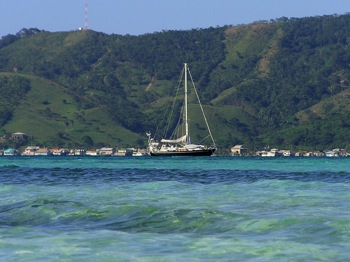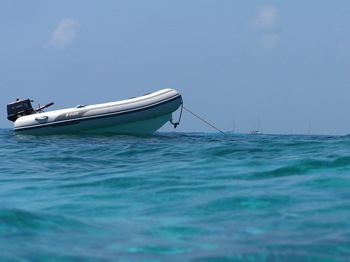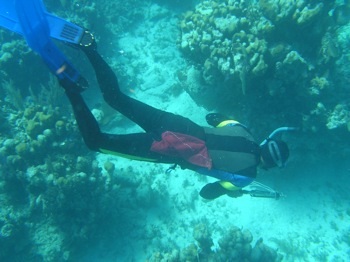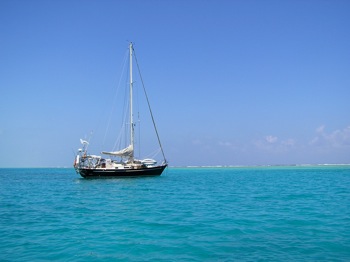Medical concerns are a priority with many cruisers including commuter cruisers. One of the things I will never understand is why more cruisers don’t carry fairly complete medical kits aboard. We have never had an instance where we were unable to get quality medical care when we needed it, but medications can be trickier. Sometimes they’re available IF you happen to be in a major port with farmacias. But in some of the out of the way cruisers enjoy hanging out, there are often no farmacias.
Before we left, I made an appointment with my family doctor, who happens to be a scuba diver so he was familiar with a lot of what I was talking about – being in out of the way places on a sailboat that travels 5 mph and only in good weather. I prepared a list of questions in advance and discussed how to prepare for anything I could foresee. We were correct in assuming we could probably get medical advice either in person from another cruiser that happened to be a doctor, from a local clinic or over the SSB radio from a doctor. But often we would need specific medications based on what that doctor told us. While most medications are generally available in port, we didn’t want to rely on getting to a port with a well-stocked farmacia if we could “fix” minor ailments by using our medical kit.

Here are 10 questions to discuss with your doctor regarding your boat’s medical kit:
1. First list every medical condition you and your crew are prone to …. for us that was David: bronchitis, sciatic nerve/back pain, ear infections from diving; Jan: sinus infections, giardia, ear infection/diving, teeth; then try to anticipate potential situations that might arise while out cruising: ours were: staph infection from cut, pain/broken bone, pinkeye or other eye infection, poison ivy/oak. We also carried meds for malaria, but never had the need to take them.
1. General Spectrum Antibiotics. We carry two different broad spectrum antibiotics, one for internal stuff and one for external, like skin etc. Our doctor chose cipro and keflex (generics of course) for our two broad spectrum antibiotics. We also carry a specialized antibiotic to treat my husband’s bronchitis because we discovered the hard way that neither of the two broad spectrum antibiotics helped his bronchitis.
2. Allergic Reactions. An Epi-Pen, although neither of us are allergic to anything that we know of, it certainly would not be a good time to find out if we were out of range of medical help! We also carry an inhaler/bronchial dialator called albuterol just in case.
3. Montezuma’s Revenge … every now and then, it’s a reality of life. We carried Flagyl for giardia until we were out of the country. Other countries have much better drugs for giardia. You have to ask at the pharmacia. Of course there may be a reason these drugs are not approved for use in the US, so beware. We’ve taken them over the years with no ill effects that we’re aware of other than our giardia went away. You probably want to carry some rehydrating drinks and over the counter diarrhea meds.
4. Eye and Ear antibiotic drops … self explanatory. In addition, we always use ear drops made from a solution of 1/2 alcohol and 1/2 white vinegar to dry out our ears after diving/snorkeling. Since we started using the alcohol/vinegar ear drops, we haven’t had an ear infection.

5. Pain. We have ibuprophen, aleve and vicodin.
6. Vomiting: we have phenergan suppositories, although these are a pain because they need to be kept cool.
7. Back Pain: We have skelaxin, a muscle relaxant as well as vicodin for pain, but rely mainly on ibuprophen and heating/ice packs unless it’s really bad.
8. Pico Pico: PicoPico is a skin irritation caused by itty bitty stinging critters as the tropical water warms up every spring. The best protection is to wear a full skin or lightweight dive suit, but every year cruisers get surprised. We have a steriod skin cream for treating it as it can be very uncomfortable.
9. First Aid supplies. Our doctor tried to convince us to take sutures and all the stuff to do them, I opted for large butterflies thinking that I would never be able to stab a needle through either my own skin or someone elses! Be sure to have waterproof first aid tape, gauze, bandaids, neosporin or whatever your choice of antibiotic ointment or cream, sunscreen, bug repellant, sunburn lotion,
9. Misc other stuff, for example, I carry yeast infection medication. We also carry a general purpose “magic” pill originally prescribed by my current doctor as a precaution against altitude sickness when we did some inland touring/Machu Picchu. It’s called Dexamethason and apparently is good for any kind of swelling/allergic reaction as well as altitude sickness. We use it for bee stings, sprained wrists or ankles, anything involving first aid induced swelling.

Having a well-stocked medical kit can often mean the difference between having to seek medical attention while days away from a port with these services, or just figuring out you have an ear infection and taking the appropriate antibiotics or antibiotic ear drops.
This post does NOT constitute medical advice, we are generally healthy with no health issues. The important part of this post is to have a discussion with your doctor before you go cruising and put together a well stocked medical kit tailored to your specific needs!
Did I forget something important? This is an important topic for cruisers as well as commuter cruisers. Please leave a comment and share your medical kit info with others!














A beekeeper friend of mine recommends Preparation-H for any topical swelling, itching, burning; such as bee sting.
And you forgot to mention sunscreen and burn creams.
Thanks Charles! Using Preparation H for topical itching/burning/swelling is a new one for me! We have it aboard and the logic makes sense. Sunscreen and bug spray I didn’t include in the medical kit, but good idea to make sure cruisers carry a supply, although you can usually get something, albeit expensive, wherever you’re reprovisioning.
I heartily recommend a good advanced first aid course such as Wilderness First Responder by Wilderness Medical Assoc. for anyone voyaging or adventuring in remote areas. The effort required is not light – 48 class/field hours hrs plus at least 24 hrs of pre-class study, but the knowledge and skills gained could be lifesaving for your and your crew. I took the course during our ‘land season’ and found the instruction, course materials, and active participation to be excellent.
Great post. Lots of info. Do you know what meds are available for giardia outside the US? And what cream do you carry. My partner and I are long time ER nurses, so we have often pondered the importance of medical care and a good kit. One thing I’d recommend is some sort of skin glue. Works great for smaller cuts. I always have some on hand at home…though I’ve only ever had to use it in on the dog!
Unfortunately, our cream is on the boat … and sadly enough, we’re not … at least not until October! I know it’s a prescription strength, but other than that, don’t remember. Hopefully I’ll remember when we return and can get back to you. 🙂
Hi Hilary! Sorry it took me a bit to respond. I’ve used several, but the ones I have in my med kit right now are Secnidal and Taxanid. If I remember correctly, I thought Secnidal was more effective than Taxanid. But both were better (at least for me) than Flagyl.
P.S. We have super glue aboard and thought if we needed it, that’s what we’d use — should we have something different? We also have butterflies, but I turned down a suture kit that my doctor wanted to add because I figure there’s no way we could stitch us or anybody up….
Super glue is very good in a pinch. It’s not as “clean” but in a pinch is far better than nothing. Just make sure you apply early and line edges of any laceration up well. And hold a few minutes after applied. AND don’t glue yourselves together!
Wouldn’t that be just my luck! 🙂
[…] just keep growing and growing … from paper charts to a spare exhaust elbow for the diesel to lots of meds to refurbish our first aid kit, the “Boat Book” containing USCG Documentation, copies of passports and everything important, the […]